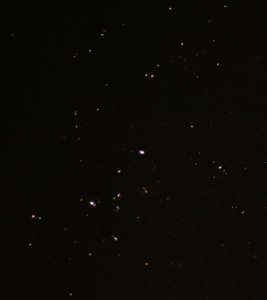How to See Kemble’s Cascade With A Telescope?

Kemble’s Cascade is an asterism in the constellation Camelopardalis featuring more than 20 stars, with the open cluster NGC 1502 at one end. This star pattern is an unofficial arrangement of stars known as an asterism and is not one of the recognized constellations in the night sky. HIP 18505 is the star in the center of Kemble’s Cascade with a magnitude of +4.9, which spreads from it to the southeast and northwest by degrees. The primary “structure” is made up of stars between mag. +7 and +8, but fainter members as low as mag. +10 supports the illusion of a straight line. Low-power telescope views are recommended since they show off the gorgeous star colors.
Quick Guide to Observe Kemble’s Cascade.
Kemble’s Cascade is best spotted in the early evenings of November and December with binoculars or a small telescope. Head north and find the two stars that make up the ends of the constellation. Imagine a line from Epsilon Cassiopeiae to Beta Cassiopeiae (Caph) (Segin). Imagine drawing a second line that is almost the same length as the first and travels in the same direction. Use your telescope to look for Kemble’s Cascade in the area where the line stops. Low-power telescope views are recommended since they show off the gorgeous star colors.
How to find Kemble’s Cascade?
Kemble’s Cascade is easily spottable in the sky. However, you can use any star map like Stellarium, SkySafari, and so on to find it. The Night Sky can help you personalize a custom star map that will display the alignment of the stars you prefer on the specific location and date you choose.
- Face north when you step outside on any clear, dark night this month. Even though Kemble’s Cascade is in the constellation Camelopardalis, you will probably only be able to see four of its stars unless you are viewing from a place with a dark sky that is largely free of light pollution.
- Depending on the time of night or season you are observing, the constellation Cassiopeia can either resemble the letter M or the letter W. Simply choose the letter you prefer because the constellation is currently standing on end in the early evening.
- Locate the two stars that make up the constellation’s endpoints. Draw an imaginary line from Beta Cassiopeiae (Caph) to Epsilon Cassiopeiae (Segin).
- Next, draw a second imaginary line that is nearly the same length as the previous one and runs in the same direction.
- With your telescope, search the region where the line ends to find Kemble’s Cascade. Depending on the size of the telescope you’re using, it will appear as a diagonal string of 15 to 25 stars that is about 2.5 degrees long and is equivalent to five full moons lined up in a row (this is why the Cascade is best seen with the wider field of view provided by telescopes rather than the more constrained eyepieces).
What is the best time to observe Kemble’s Cascade?
Stars appear to descend in a vertical cascade into the open star cluster NGC 1502 at the foot of Kemble’s Cascade. The best times to observe it with binoculars or a small telescope are in the early nights of November and December. Find the two stars that make up the constellation’s ends by facing north. Imagine a line from Epsilon Cassiopeiae to Beta Cassiopeiae (Caph) (Segin). Imagine drawing a second line that is almost the same length as the first and travels in the same direction. It will look like a diagonal string of 15 to 25 stars, roughly 2.5 degrees long and equivalent to five full moons lined up in a row, depending on the size of the telescope you’re using (this is why the Cascade is best seen with the wider field of view provided by telescopes rather than the more constrained eyepieces).
What telescope to see Kemble’s Cascade?
Both the Meade 6″ f/4.1 LX85 Reflector and the Orion 09007 SpaceProbe 130ST Equatorial Reflector are excellent telescopes for viewing Kemble’s Cascade. A list of telescopes has more telescope options that can see Kemble’s Cascade very clearly.
What size telescope to see Kemble’s Cascade?
With a 70mm telescope, you can view Kemble’s Cascade extremely clearly. The greater the aperture, the clearer and better the vistas and details.
What magnification is required to see Kemble’s Cascade?
A 50x magnification is sufficient to display the entire Kemble’s Cascade. To observe the details, 150x magnification is preferable. Most observers prefer a lower magnification, but if you have an eyepiece with a large field of vision, you can increase this.
Enjoying Kemble’s Cascade? Here are other things to see with your telescope.
Without a doubt, the vista of Kemble’s Cascade is magnificent. However, you may see thousands of jewels in the night sky with the same telescope. The moons and other features of the planets of our solar system can be seen best. The greatest ways to watch the largest planet in our solar system may be found in Viewing Jupiter Through A Telescope. You can learn how to locate different nebulae with a scope by reading Viewing Nebula Through A Telescope . To make the most of your time stargazing, pick any of the objects from the ‘List of things to see with a telescope’ instead.
